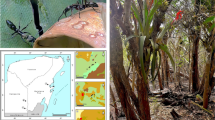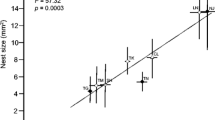Summary
Social behavior is reported for the first time in a member of the family Sparassidae (Araneae), the Australian huntsman spiderDelena cancerides Walckenaer. Unlike any previously known social spider, this is a bark dwelling species and, thus, its sociality cannot have its basis on an aerial web, the structure that has been considered central to the evolution of sociality in other spider species. Colonies ofD. cancerides may comprise up to 300 individuals living in close physical contact under the exfoliating bark of deadAcacia, Callitris andCasuarina species. Specimens maintained in the laboratory feed communally and capture prey jointly. Although this intranest tolerance and communal feeding behavior is reminiscent of other highly social spiders,D. cancerides notably differs from these other species in the extreme aggression shown towards members of foreign colonies, its outbred population structure, and lack of sex ratio bias. We suggest that sociality in this species may have been facilitated by the presence of extended maternal care in the ancestral phylogenetic lineage, as suggested by the occurrence of such behavior in related nonsocial species, and that colonial living may have arisen as a consequence of the reduction and fragmentation ofDelena's habitat associated with the rise to dominance of the eucalypts. The apparent colony recognition observed may have evolved becauseDelena's hunting habits may require mechanisms to locate one's own colony after foraging expeditions and to exclude wandering outsiders from entering one's nest, in contrast to web-bound species that do not need to leave their nest to forage. How the observed outbreeding is accomplished in the face ofDelena's extreme intolerance to members of other nests, as well as how new colonies are formed, are issues that have yet to be investigated.
Similar content being viewed by others
References
Avilés, L., 1993. Interdemic selection and the sex ratio: A social spider perspective.Am. Nat. 142:320–345.
Avilés, L., 1994. Social behavior in a web-building lynx spider,Tapinillus sp. (Araneae: Oxyopidae).Biol. J. Linnean Soc. 51:163–176.
Avilés, L., 1995. Causes and consequences of cooperation and permanent-sociality in spiders. In:Social Competition and Cooperation among Insects and Arachnids, II, Evolution of Sociality (J. Choe and B. Crespi, Eds.) Princeton University Press, Princeton, N. J.
Avilés, L. and W. P. Maddison, 1991. When is the sex ratio biased in social spiders? Chromosome studies of embryos and male meiosis inAnelosimus species (Araneae: Theridiidae).J. Arachnol. 19:126–135.
Burgess, J. W., 1978. Social behaviour in group-living spider species.Symp. Zool. Soc. Lond. 42:69–78.
Buskirk, R. E., 1981. 4. Sociality in the Arachnida. In:Social Insects II (H. R. Hermann, Ed.), pp. 281–367. Academic Press, New York, London.
Coleman, E., 1941. Further notes on the huntsman spider (Isopoda immanis).Via. Nat. 58:88–90.
D'Andrea, M., 1987. Social behaviour in spiders (Arachnida, Araneae).Itali. J. Zool., N. S. Monogr. 3.
Evans, T. A. (in press). Two new species of social crab spiders of the genusDiaea from Eastern Australia, their natural history and distribution.Rec. West. Austral. Mus., supp. 151–158.
Hamilton, W. D., 1967. Extraordinary sex ratios.Science 156:477–488.
Hancock, A. J. and D. M. Rowell (in press). A chromosomal hybrid zone inDelena cancerides.Aust. J. Zool.
Henschel, J. R., 1990. The biology ofLeucorchestris arenicola (Araneae: Heteropodidae), a burrowing spider of the Namib dunes. In:Namib Ecology: 25 years of Namib Research (M. K. Seely, Ed.), pp. 115–127.Transvaal Mus. Monograph No. 7, Transvaal Museum, Pretoria.
Hogg, H. R., 1902. On the Australian spiders of the subfamily Sparassinae.Proc. zool. Soc. Lond. 2:218–279.
Kirkendall, L. R. and K. Raffa, 1995. Interactions among males, females and offspring in bark beetles: the significance of living in holes for the evolution of social behavior. In:Social Competition and Cooperation among Insects and Arachnids, II, Evolution of Sociality (J. Choe and B. Crespi, Eds.) Princeton University Press, Princeton, New Jersey, USA.
Krafft, B., 1979. Organisation et évolution des société d'araignées.J. Psychol 1:23–51.
Kullmann, E., 1972. Evolution of social behavior in spiders (Araneae; Eresidae and Theridiidae).Am. Zool. 12:419–426.
Lange, R. T., 1980. Evidence for lid cells and host specific microfungi in the search for TertiaryEucalyptus.Review of Palaeobotany and Palynology 29:29–33.
Main, B. Y., 1988. The biology of a social thomisid spider.Austral. Arachnol. [Aust. Ent. Soc. Misc. Publ., Brisbane] 5:55–73.
Nentwig, W., 1985. Social spiders catch larger prey: a study ofAnelosimus eximius (Araneae: Theridiidae).Behav. Ecol. Sociobiol. 17:79–85.
Pasquet, A. and B. Krafft, 1992. Cooperation and prey capture efficiency in a social spider,Anelosimus eximius (Araneae, Theridiidae).Ethology 90:121–133.
Riechert, S. E. and R. M. Roeloffs, 1993. Evidence for and consequences of inbreeding in the cooperative spiders. In:The Natural History of Inbreeding and Outbreeding. (N. Thornhill. Ed.) The University of Chicago Press, Chicago, pp. 283–303.
Roewer, C. F., 1954 Katalog der Araneae von 1758 bis 1940 bsw. 1954 2b:927–1751. Inst. Roy. Sci Nat. Belgique, Bruxelles.
Rowell, D. M., 1985. Complex sex-linked fusion heterozygosity in the Australian huntsman spiderDelena cancerides (Araneae: Sparassidae).Chromosoma 93:169–176.
Rowell, D. M., 1986. Complex sex-linked translocation heterozygosity and its role in the evolution of social behaviour.Can. J. Genet. Cytol. 28:168–170.
Rowell, D. M., 1988. The chromosomal constitution ofDelena cancerides Walck. (Araneae: Sparassidae) and its role in the maintenance of social behaviour. In:Australasian Arachnology, Australian Entomology Society, Miscellaneous Publications Series. No. 5.
Rowell, D. M., 1990. Complex fusion heterozygosity inDelena cancerides (Araneae: Sparassidae): An alternative to speciation by monobrachial homology.Genetica 80:139–157.
Rowell, D. M., 1991a. Chromosomal fusion and meiotic behaviour inDelena cancerides (Araneae: Sparassidae) I. Pairing and X-chromosome segregation.Genome 34:561–566.
Rowell, D. M., 1991b. Chromosomal fusion and meiotic behaviour inDelena cancerides (Araneae: Sparassidae) II. Chiasma position and its implications for speciation.Genome 34:567–573.
Rowell, D. M. and B. Y. Main, 1992. Sex ratio in the social thomisid,Diaea socialis. J. Arachnol. 20:200–206.
Sokal, R. R. and F. J. Rohlf, 1981. Biometry, 2nd Edition. W. H. Freeman and Co., San Francisco.
Simon, E., 1880. Révision de la famille des Sparassidae (Arachnides).Actes de la Société Linnéenne de Bordeaux 1880:223–351.
Singh, G., 1982. Chapter 4. Environmental upheaval. In:A History of Australian Vegetation. (Smith J. M. B. ed.) McGraw-Hill, Sydney.
Smith, D. R. and M. S. Engel, 1994. Population structure in an Indian cooperative spider,Stegodyphus sarasinorum Karsch (Eresidae).J. Arachnol. 22:108–113.
Shear, W. A., 1970. The evolution of social phenomena in spiders.Bull. Brit. Arach. Soc. 1:65–76.
Swofford, D. L. and R. K. Seiander, 1981. A computer program for the analysis of allelic variation in genetics.J. Hered. 72:281–283.
Tretzel, E., 1961. Biologie, Ökologie und Brutpflege vonCoelotes terrestris (Wider) (Araneae, Agelenidae). Teil I: Biologie und Ökologie. Teil II: Brutpflege.Z. Morph. Okol. Tiere 49:658–745,50:375–542.
Truswell, E. M., 1993. Vegetation changes in the Australian Tertiary in response to climatic and phytogeographic forcing factors.Australian Systematic Botany 6:533–557.
Uetz, G. W. and C. S. Hieber, 1995. Colonial web-building spiders: balancing the costs and benefits of group-living. In:Social Competition and Cooperation among Insects and Arachnids, II, Evolution of Sociality (J. Choe and B. Crespi, Eds.) Princeton University Press, Princeton, N. J.
Walckanaer, C. A., 1837.Histoire Naturelle des Insectes Aptères. Tome Premier. Paris. Libraire encyclopédique de Roret.
Ward, P. I. and M. M. Enders, 1985. Conflict and cooperation in the group feeding of the social spiderStegodyphus mimosarum.Behaviour 94:167–182.
Williams, G. C., 1966.Adaptation and Natural Selection. Princeton University Press, Princeton, N. J.
Author information
Authors and Affiliations
Rights and permissions
About this article
Cite this article
Rowell, D.M., Avilés, L. Sociality in a bark-dwelling huntsman spider from Australia,Delena cancerides Walckenaer (Araneae: Sparassidae). Ins. Soc 42, 287–302 (1995). https://doi.org/10.1007/BF01240423
Received:
Revised:
Accepted:
Issue Date:
DOI: https://doi.org/10.1007/BF01240423




